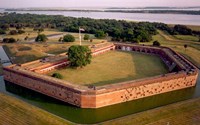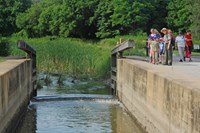- Lesson Plan (51)
- Field Trips (16)
- Traveling Trunk (11)
- Teacher Reference Materials (10)
- Other Education Materials (5)
- Student Activities (5)
- Primary Sources (2)
- Distance Learning (1)
- Media for Loan (1)
- Science Labs (1)
- Homestead National Historical Park (6)
- Cowpens National Battlefield (4)
- Cuyahoga Valley National Park (4)
- Everglades National Park (4)
- Florissant Fossil Beds National Monument (4)
- Glacier National Park (4)
- Knife River Indian Villages National Historic Site (4)
- Acadia National Park (3)
- Alaska Public Lands (3)
- Show More ...
- Social Studies (71)
- Science (38)
- Literacy and Language Arts (23)
- Math (8)
- 6-8.RH.7 (7)
- 6-8.RH.9 (7)
- 9-10.RH.2 (7)
- 3.RI.3 (6)
- 6-8.RH.2 (6)
- 6-8.RH.4 (6)
- 9-10.RH.1 (6)
- 9-10.RH.10 (6)
- 9-10.RH.3 (6)
- Show More ...
Showing 99 results for recycled material ...
Colonial Correspondence Material
- Type: Field Trips
- Grade Levels: Middle School: Sixth Grade through Eighth Grade
No image provided
Material Culture: the Fife and Drum
- Type: Lesson Plan
- Grade Levels: Middle School: Sixth Grade through Eighth Grade
How does music from the Battle of Cowpens help us understand this historical event?
Material Culture: The Powder Horn
- Type: Lesson Plan
- Grade Levels: Middle School: Sixth Grade through Eighth Grade
To introduce to students material culture related to the Battle of Cowpens.
Fort Pulaski Pre-Visit Materials
Creating Sculptures from Natural Materials
- Type: Field Trips
- Grade Levels: High School: Ninth Grade through Twelfth Grade
George Washington Carver - An Original Conservationist: Alternative Uses for Everyday Materials
- Type: Lesson Plan
- Grade Levels: High School: Ninth Grade through Twelfth Grade

This topic is a focus on alternative uses for source materials and products that can be made with alternative materials. Students will make peanut milk in an effort to understand how foods can be used in different ways to increase nutrition to the consumer. Students will create a pros/cons poster researching products (such as fuel) and comparing traditional source materials (crude oil) with alternative materials (corn or soy-based ethanol).
Build Your Own National Park
George Washington Carver - The Artist: To Be of the Greatest Good
'Ie Toga (Fine Mat): Samoan Traditions of Weaving
- Type: Lesson Plan
- Grade Levels: Upper Elementary: Third Grade through Fifth Grade

The giving and receiving of ‘ie tōga (fine mats) is an integral part of Fa’a Samoa (Samoan Way). These fine mats are used for special occasions such as weddings, funerals, and the bestowing of chiefly titles. Fine mats have been passed down from generation to generation. These fine mats are as enduring as our Samoan culture.
Ohio & Erie Canal: Teacher Resources
Wetlands: Teacher Resources
Prehistoric Native Americans: Teacher Resources
Northeast Ohio Geology: Teacher Resources
Women at Floyd Bennett Field
- Type: Teacher Reference Materials
- Grade Levels: Middle School: Sixth Grade through Eighth Grade
National Park Labs: Studies of Wildland Fire Ecology
- Type: Science Labs
- Grade Levels: High School: Ninth Grade through Twelfth Grade

National Park Labs: Studies of Wildland Fire Ecology curriculum is progressive and builds on the knowledge of each prior lesson. Teacher materials include guidelines that provide the concept, objective, method, materials, duration, procedures for conducting lessons, student handouts, and student investigation worksheets.
The Homestead Act of 1862 (K-2)
- Type: Traveling Trunk
- Grade Levels: Lower Elementary: Pre-Kindergarten through Second Grade

The trunk includes curriculum materials, books, and photos that can be integrated into history, social studies, art, reading, and language arts curriculum. Additionally, the curriculum materials include student station sheets, so students can rotate stations without the teacher having to repeat instructions.
- Type: Traveling Trunk
- Grade Levels: High School: Ninth Grade through Twelfth Grade

The trunk includes curriculum materials, books, documents and a DVD that can be integrated into history, social studies, reading, and language arts curriculum. Additionally, the curriculum materials include student station sheets, so students can rotate stations without the teacher having to repeat instructions.
Sand Density
- Type: Student Activities
- Grade Levels: Upper Elementary: Third Grade through Fifth Grade
This activity, which uses sand, helps students will understand material density as it relates to water and sedimentary rocks.











